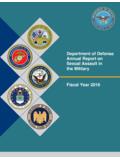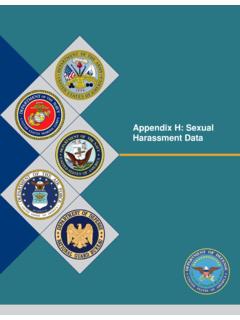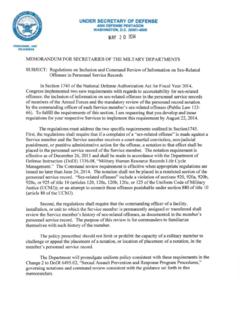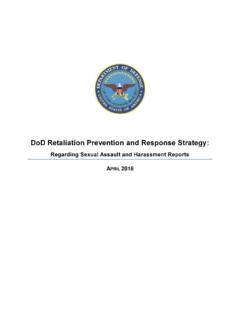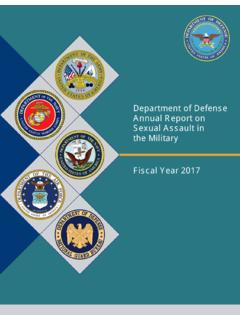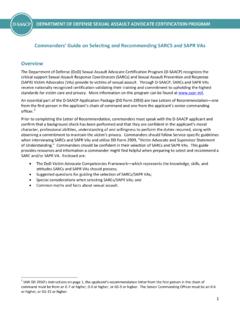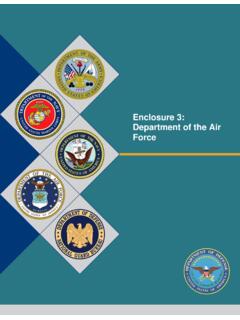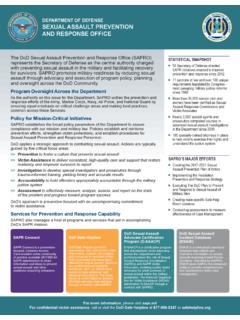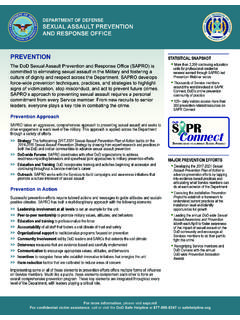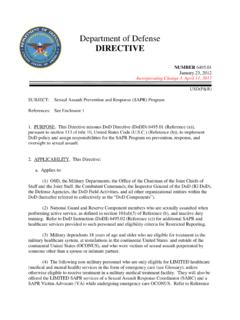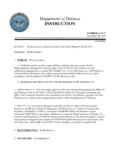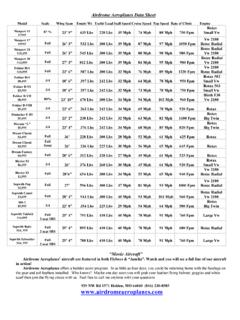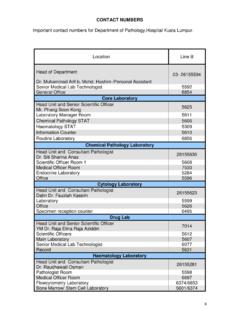Transcription of INFO PAPER ISSUANCE OF CHANGE 2 TO DOD …
1 info PAPER ISSUANCE OF CHANGE 2 TO DOD INSTRUCTION , SEXUAL ASSAULT PREVENTION AND RESPONSE PROGRAM PROCEDURES JULY 2015 Background The detailed procedures for implementation of the Sexual Assault Prevention and Response (SAPR) Directive are established in DoD SAPR Instruction , Sexual Assault Prevention and Response Program Procedures. The SAPR Instruction was originally issued June 23, 2006, and was reissued on March 28, 2013. A CHANGE 1 to the SAPR Instruction was published on February 12, 2014, incorporating National Defense Authorization Act (NDAA) for Fiscal Year (FY) 2013 provisions. A CHANGE 2 was published to implement requirements outlined in the NDAAs, initiatives directed by the Secretary of Defense (SecDef), formal recommendations from the Response Systems to Adult Sexual Assault Crimes Panel (RSP), clarifications to the existing SAPR policy, and new substantive changes to address areas of need; to include retaliation efforts and training.
2 CHANGE 2 was published on July 7, 2015, and can be accessed here: or Summary of Changes Improving Victim Response: Changes incorporate recommendations from the RSP, incorporate initiatives directed by the SecDef, and reflect current law. Updated procedures are provided for the following: ensuring that victims from the Reserve Component and National Guard are eligible for SAPR services, requiring the Services to support the DoD Safe Helpline, requiring a safety assessment for all victims of sexual assault, incorporating victim feedback, integrating legal assistance programs for victims, and providing retention requirements for DD Forms 2910 (election of reporting option) and 2911 (forensic examination report). Highlights include: In the Annual SAPR training, explanation of the codification and enhancement of victims rights in the military.
3 ( 1701 of NDAA FY14, 534 of NDAA FY15) Provision that Service member victim s alleged collateral misconduct will be excluded from consideration as intentional misconduct or gross negligence in Line of Duty determinations and other guidance regarding Line of Duty determination procedures. Requirement for explanation of right to consult with Special Victims Counsel (SVC)/Victims Legal Counsel (VLC) and the types of legal assistance available. (RSP Recommendation #61, 1716 of NDAA FY14) Clarification of roles and responsibilities of the monthly SAPR Case Management Group (CMG) members to assure collaboration among responders. Requirements for Sexual Assault Forensic Examination Kit collection and preservation. Requirement to notify sexual assault victims to answer no to Question 21 on Standard Form 86, if consultation with health care professional meets outlined criteria.
4 ( 1747 of NDAA FY14) DoD Sexual Assault Prevention and Response Office 2 Consistent with the Presidential Memorandum Implementing the Prison Rape Elimination Act, sexual assaults in DoD confinement facilities involving Service members will be governed by the National Standards to Prevent, Detect and Respond to Prison Rape. Addressing Retaliation: Changes incorporate SecDef Initiatives, RSP recommendations, and new policy provisions. Updated procedures are provided for the following: establishing comprehensive retaliation training requirements and procedures to require commanders to protect those who report or intervene to prevent a sexual assault. New procedures for the CMG Chair to ask CMG members if the victim, witnesses, bystanders (who intervened), Sexual Assault Response Coordinators (SARCs) and SAPR Victim Advocates (VAs), responders, or other parties to the incident have experienced any incidents of retaliation, reprisal, ostracism, or maltreatment.
5 If any allegations are reported, the CMG Chair will forward the information to the proper authority or authorities ( , military criminal investigative organization (MCIO), Inspector General (IG), Military Equal Opportunity (MEO)). (3 December 2014 SecDef Initiative) Highlights of the training requirements include: - Explaining what constitutes retaliation, reprisal, ostracism, and maltreatment in accordance with Service regulations and Military Whistleblower Protections. Explaining what is the appropriate, professional response by peers to a victim and an alleged offender when a sexual assault is reported in a unit. Required to utilize scenarios to facilitate discussion of appropriate behavior, to include discussing potential resentment of peers for victim or witness, who reports a sexual assault and opens up unit to scrutiny.
6 Explaining that ALL supervisors in the victim s chain of command, officer and enlisted, are required when they become aware of allegations of retaliation, reprisal, ostracism, or maltreatment, to take appropriate measures to protect the victim from retaliation, reprisal, ostracism, and maltreatment in Unrestricted Reports. - Requirement that SARCs and SAPR VAs must inform victims of the resources available to report instances of retaliation, reprisal, ostracism, maltreatment, sexual harassment or to request a transfer or Military Protective Order (MPO). If the allegation is criminal in nature and the victim filed an Unrestricted Report, the crime should be immediately reported to a MCIO, even if the crime is not something normally reported to an MCIO ( , victim s personal vehicle was defaced).
7 Victims can seek assistance on how to report allegations by requesting assistance from: A SARC or SAPR VA or SVC/VLC. A SARC on a different installation, which can be facilitated by the Safe Helpline. Their immediate commander. A commander OUTSIDE their chain of command. Service personnel to invoke their Service-specific reporting procedures regarding such allegations. Service MEO representative to file a complaint of sexual harassment. A General/Flag Officer (G/FO), if the retaliation, reprisal, ostracism, or maltreatment involves the administrative separation of victims within one DoD Sexual Assault Prevention and Response Office 3 year of the final disposition of their sexual assault case. A victim may request that the G/FO review the separation.
8 A G/FO if the victim believes there has been an impact on their military career because they reported a sexual assault or sought mental health treatment associated with the sexual assault. The victim may discuss the impact with the G/FO. An SVC or VLC, trial counsel and Victim Witness Assistance Program personnel, or a legal assistance attorney to facilitate reporting with a SARC or SAPR VA. Service personnel to file an Article 138, Complaint of Wrongs, in the UCMJ. DoD IG, invoking whistle-blower protections. Commander or SARC to request an Expedited Transfer. Commander or SARC to request a safety transfer or an MPO and/or Civil Protective Order, if the victim is in fear for her or his safety. The MCIO, if the allegation is of an act that is criminal in nature and the victim filed an Unrestricted Report.
9 (In this case, the allegation should immediately be reported to an MCIO.) - Explaining Service regulations that protect the SARC and SAPR VA from retaliation, reprisal, ostracism, and maltreatment related to the execution of their duties and responsibilities. - Explaining Service regulations that protect witnesses and bystanders who intervene to prevent sexual assaults or those who report sexual assaults from retaliation, reprisal, ostracism, and maltreatment. Reinforcing Prevention: Changes incorporate recommendations from the RSP, incorporate initiatives directed by the SecDef, and reflect current law. Updated procedures are provided for requiring command assessments of organizational SAPR climate and including prevention in SAPR curriculum and training requirements for the Military Service Academies.
10 One example: Establishes prevention practices consistent with respective Service s implementation of the Department of Defense 2014-2016 Sexual Assault Prevention Strategy, to ensure prevention programs address concerns about unlawful command influence so victims rights are protected, and at the same time, the due process rights of the alleged suspects are safeguarded. (RSP Recommendation #80) Improving Procedures for SAPR Personnel: Changes incorporate recommendations from the RSP and reflect current law. Updated procedures are provided for the Command Team, SARCs/SAPR VAs, and Health Care Providers. Highlights include: Commanders and SAPR Program Managers Requirement that commanders will, through their installation law enforcement agency, place an active MPO in the National Crime Information Center for the duration of the order.
